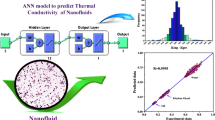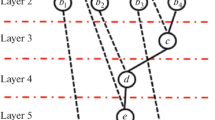Abstract
High thermal conductivity of carbon nanotube nanofluids (knf) has received great attention. However, the current researches are limited by experimental conditions and lack a comprehensive understanding of knf variation law. In view of proposition of data-driven methods in recent years, using experimental data to drive prediction is an effective way to obtain knf, which could clarify variation law of knf and thus greatly save experimental and time costs. This work proposed a neural regression model for predicting knf. It took into account four influencing factors, including carbon nanotube diameter, volume fraction, temperature and base fluid thermal conductivity (kf). Where, four conventional fluids with kf, including R113, water, ethylene glycol and ethylene glycol-water mixed liquid were considered as base fluid considers. By training this model, it can predict knf with different factors. Also, change law of four influencing factors considered on the knf enhancement has discussed and the correlation between different influencing factors and knf enhancement is presented. Finally, compared with nine common machine learning methods, the proposed neural regression model shown the highest accuracy among these.
Similar content being viewed by others
References
Zhang X., Song L., Cai L., et al., Optical visualization and polarized light absorption of the single-wall carbon nanotube to verify intrinsic thermal applications. Light-Science & Applications, 2008, 4(8): e318.
Keblinski P., Phillpot S.R., Choi S.U.S., et al., Mechanisms of heat flow in suspensions of nano-sized particles (nanofluids). International Journal of Heat and Mass Transfer, 2002, 45(4): 855–863.
Eastman J.A., Phillpot S.R., Choi S.U.S., et al., Thermal transport in nanofluids. Annual Review of Materials Research, 2004, 34(1): 219–246.
Qiu L., Zhu N., Feng Y., et al., A review of recent advances in thermophysical properties at the nanoscale: From solid state to colloids. Physics Reports, 2020, 843: 1–81.
Longon G.A., Zilio C., Ceseracciu E., et al., Application of Artificial Neural Network (ANN) for the prediction of thermal conductivity of oxide-water nanofluids. Nano Energy, 2012, 1(2): 290–296.
Aminian A., Predicting the effective thermal conductivity of nanofluids for intensification of heat transfer using artificial neural network. Powder Technology, 2016, 301: 288–309.
Hemmat Esfe M., Motahari K., Sanatizadeh E., et al., Estimation of thermal conductivity of CNTs-water in low temperature by artificial neural network and correlation. International Communications in Heat and Mass Transfer, 2016, 76: 376–381.
Yousefi F., Mohammadiyan S., Karimi H., Application of artificial neural network and PCA to predict the thermal conductivities of nanofluids. Heat and Mass Transfer, 2016, 52(10): 2141–2154.
Shahsavar A., Bahiraei M., Experimental investigation and modeling of thermal conductivity and viscosity for non-Newtonian hybrid nanofluid containing coated CNT/Fe3O4 nanoparticles. Powder Technology, 2017, 318: 441–450.
Esfahani J.A., Safaei M.R., Goharimanesh M., et al., Comparison of experimental data, modelling and non-linear regression on transport properties of mineral oil based nanofluids. Powder Technology, 2017, 317: 458–470.
Bagherzadeh S.A., D’Orazio A., Karimipour A., et al., A novel sensitivity analysis model of EANN for F-MWCNTs-FeO/EG nanofluid thermal conductivity: Outputs predicted analytically instead of numerically to more accuracy and less costs. Physica A: Statistical Mechanics and its Applications, 2019, 521: 406–415.
Aisyah S., Harahap M., Siregar A.M.H., et al., Optimization of training backpropagation algorithm using nguyen widrow for angina ludwig diagnosis. Journal of Physics Conference Series, 2018, 1007: 012050.
Wilamowski B.M., Yu H., Improved computation for Levenberg-Marquardt Ttraining. IEEE Transactions on Neural Networks, 2010, 21(6): 930–937.
Zhang L., Suganthan P.N., A survey of randomized algorithms for training neural networks. Information Sciences, 2016, 364–365: 146–155.
Kayri M., Predictive abilities of Bayesian regularization and Levenberg-Marquardt algorithms in artificial neural networks: a comparative empirical study on social data. Mathematical and Computational Applications, 2016, 21(2): 20.
Jiang W., Ding G., Peng H., Measurement and model on thermal conductivities of carbon nanotube nanorefrigerants. International Journal of Thermal Sciences, 2009, 48(6): 1108–1115.
Soltanimehr M., Afrand M., Thermal conductivity enhancement of COOH-functionalized MWCNTs/ethylene glycol-water nanofluid for application in heating and cooling systems. Applied Thermal Engineering, 2016, 105: 716–723.
Xing M., Yu J., Wang R., Experimental study on the thermal conductivity enhancement of water based nanofluids using different types of carbon nanotubes. International Journal of Heat and Mass Transfer, 2015, 88: 609–616.
Shamaeil M., Firouzi M., Fakhar A., The effects of temperature and volume fraction on the thermal conductivity of functionalized DWCNTs/ethylene glycol nanofluid. Journal of Thermal Analysis and Calorimetry, 2016, 126(3): 1455–1462.
Jha N., Ramaprabhu S., Thermal conductivity studies of metal dispersed multiwalled carbon nanotubes in water and ethylene glycol based nanofluids. Journal of Applied Physics, 2009, 106(8): 084317.
Amrollahil A., Hamidi A.A., Rashidi A.M., The effects of temperature, volume fraction and vibration time on the thermo-physical properties of a carbon nanotube suspension (carbon nanofluid). Nanotechnology, 2008, 19(31): 315701.
Glory J., Bonetti M., Helezen M., et al., Thermal and electrical conductivities of water-based nanofluids prepared with long multiwalled carbon nanotubes. Journal of Applied Physics, 2008, 103(9): 094309.
Hemmat Esfe M., Saedodin S., Mahian O., et al., Heat transfer characteristics and pressure drop of COOH-functionalized DWCNTs/water nanofluid in turbulent flow at low concentrations. International Journal of Heat and Mass Transfer, 2014, 73: 186–194.
Acknowledgements
This study is financially supported by Beijing Nova Program (No. Z201100006820065), National Natural Science Foundation of China (No. 51876007 and No. 51876008), Beijing Natural Science Foundation (No. 3202020) and Interdisciplinary Research Project for Young Teachers of USTB (Fundamental Research Funds for the Central Universities, No. RF-IDRY-19-004).
Author information
Authors and Affiliations
Corresponding authors
Rights and permissions
About this article
Cite this article
Zou, H., Chen, C., Zha, M. et al. A Neural Regression Model for Predicting Thermal Conductivity of CNT Nanofluids with Multiple Base Fluids. J. Therm. Sci. 30, 1908–1916 (2021). https://doi.org/10.1007/s11630-021-1497-1
Received:
Published:
Issue Date:
DOI: https://doi.org/10.1007/s11630-021-1497-1




